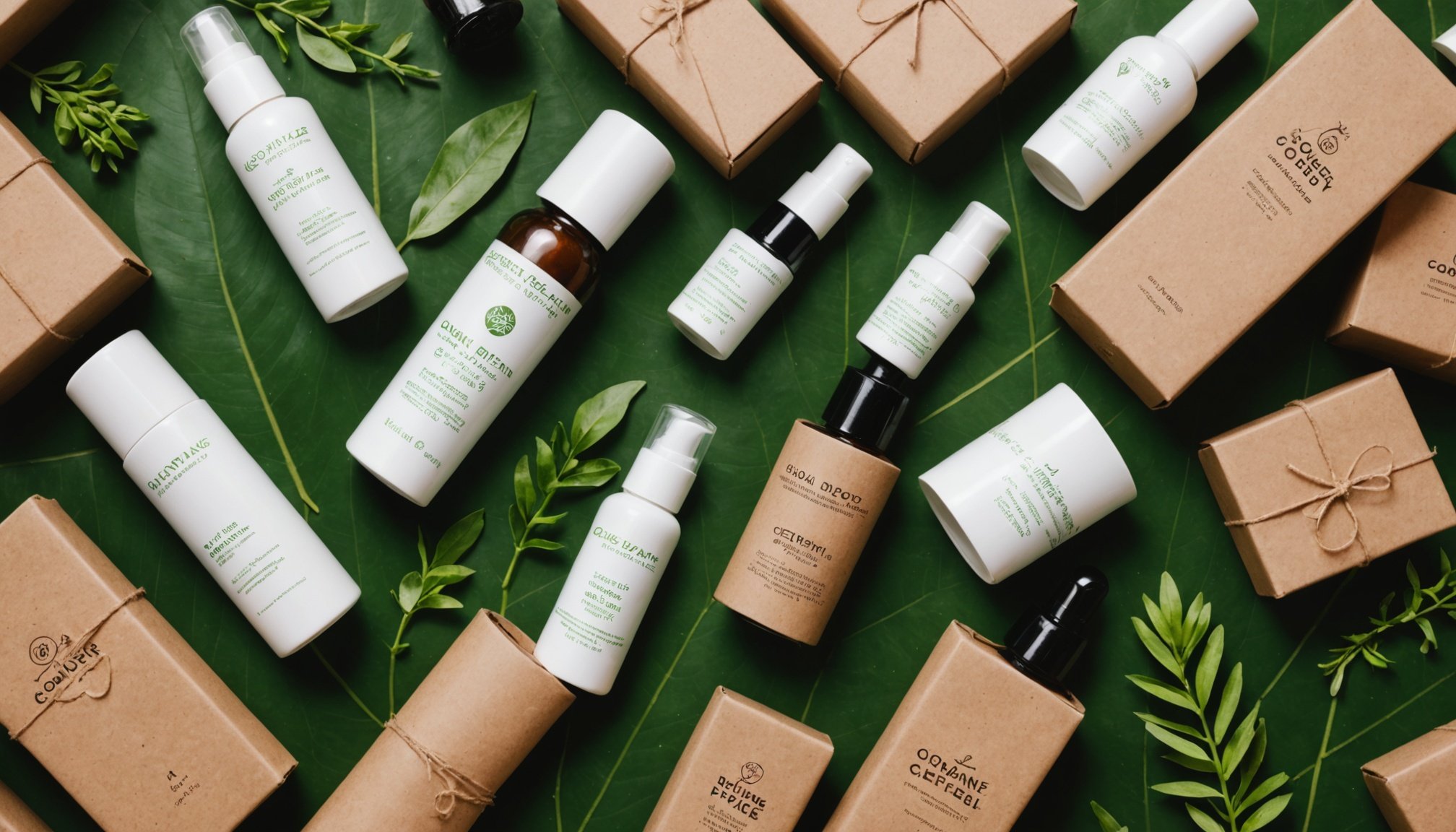Understanding Eco-Friendly Packaging in the Beauty Industry
The beauty industry is experiencing a significant shift with the rise of eco-friendly packaging. This approach reduces environmental impact by leveraging materials that are less harmful and more sustainable. Currently, the industry’s standards are evolving, with a clear emphasis on reducing packaging waste and incorporating sustainable practices. As consumers become more eco-conscious, they expect beauty brands to reflect these values in their packaging.
Eco-friendly packaging plays a critical role in mitigating the adverse effects of packaging waste on the environment. It involves using materials like biodegradable or recyclable options that minimize landfill contributions and reduce carbon footprints. Sustainable practices in packaging not only address waste issues but also help conserve natural resources.
Have you seen this : Revolutionary strategies for eco-friendly water management in uk agriculture: paving the way for a sustainable future
Understanding current beauty industry standards helps brands align with consumer expectations. Modern consumers are increasingly scrutinizing the environmental credentials of the products they purchase. Consequently, brands that adopt eco-friendly packaging not only meet these consumer demands but also demonstrate a commitment to environmental sustainability.
By adopting more sustainable practices, the beauty industry can contribute significantly to environmental conservation. This shift not only satisfies consumer demand but also positions brands as leaders in sustainability, ultimately fostering brand loyalty and enhancing reputation.
Also to see : Empowering uk enterprises: essential open innovation tactics for success
Benefits of Sustainable Packaging for UK Beauty Brands
Sustainable packaging offers numerous advantages for UK beauty brands aiming to enhance their brand reputation and establish strong connections with eco-conscious consumers. A significant benefit involves bolstering brand reputation through environmentally responsible practices. By aligning with consumer values towards sustainability, brands can foster consumer loyalty. Modern shoppers are keen on supporting companies committed to reducing their environmental footprint, making eco-friendly packaging a valuable differentiator in the competitive beauty market.
Financially, adopting sustainable packaging can lead to potential cost savings in the long run. Although initial investments might rise due to sourcing sustainable materials, efficiencies often grow over time as brands streamline their supply chains and reduce waste. Brands that adopt innovative sustainable practices can even uncover opportunities for creating reusable or multi-use products, further capitalizing on their investment.
Moreover, staying ahead of consumer expectations by embracing sustainable packaging not only positions brands as leaders in the security-conscious market but also attracts customers interested in minimizing environmental impact. Ultimately, the transition to sustainable packaging is a strategic move that aligns with current beauty industry standards and demands, simultaneously benefiting the planet and reinforcing a brand’s commitment to environmental sustainability.
Materials and Technologies for Eco-Friendly Packaging
In the pursuit of reducing environmental footprints, the beauty industry is increasingly adopting sustainable materials and biodegradable packaging. Key materials include compostable bioplastics, glass, and recycled paper, serving as alternatives to traditional plastics. Innovative technologies are also being leveraged to develop packaging solutions that minimize waste and promote recyclability, enhancing ecological sustainability. These technologies often encompass advancements like water-soluble films and plant-based resins, designed to slowly degrade without leaving harmful residues.
Biodegradable and Recyclable Materials
Packaging innovations focus on using biodegradable materials such as polylactic acid (PLA) and cornstarch composites, which break down more readily in natural environments compared to conventional plastics. Recyclable packaging components, including aluminium and glass, are also becoming more popular, minimizing landfill waste and promoting circularity in packaging life cycles.
Innovative Packaging Solutions
Tech-driven solutions, such as smart packaging incorporating QR codes for recycling instructions, are emerging to inform and engage consumers. These solutions not only fulfill operational efficiency but also resonate with environmentally aware consumers, providing clear pathways for post-consumer recycling or composting.
Case Studies of Material Use
Noteworthy brands like Lush and Aveda exemplify successful adoption of sustainable packaging. They’ve pioneered the use of biodegradable pots and bottles made from post-consumer recycled materials, setting standards within the industry. This approach demonstrates scalability and reflects a commitment to sustainability in beauty products.
Practical Tips for Implementing Sustainable Packaging Solutions
Transitioning to more eco-friendly packaging solutions in the beauty industry necessitates strategic planning and collaboration. Here are some practical tips to help beauty brands embark on this sustainable journey:
Firstly, conduct a comprehensive assessment of current packaging practices. Identify areas where improvements can be made, such as reducing excess packaging or replacing non-recyclable materials. Understanding the existing processes sets a foundation for sustainable transitions.
Secondly, when selecting eco-friendly packaging materials, prioritize those that align with brand ethos and consumer values. For example, opting for biodegradable packaging options or materials made from recycled content speaks volumes about a brand’s commitment to environmental sustainability.
Collaboration is key. Establish partnerships with suppliers who specialize in sustainable materials to ensure the consistent availability of eco-conscious options. Suppliers can also offer insights into innovative technologies that enhance sustainability without compromising product integrity.
Lastly, implement packaging strategies that not only meet beauty industry standards but also resonate with consumer expectations. Incorporate feedback mechanisms like surveys to gather insights directly from consumers, ensuring strategies remain aligned with ever-evolving eco-conscious demands.
By following these tips, brands can make sustainable transitions that benefit both the environment and their business growth.
Regulatory Considerations for Eco-Friendly Packaging
Navigating through today’s regulatory compliance landscape is integral for brands dedicated to sustainable packaging in the beauty industry. As environmental legislation increasingly dictates packaging guidelines, brands must remain vigilant in understanding these evolving sustainability guidelines. This compliance is crucial not only for avoiding penalties but also for maintaining consumer trust, as regulations often mirror public expectations for environmentally responsible practices.
Current regulations, such as the UK’s Plastic Packaging Tax, encourage the reduction of single-use plastics, compelling companies to shift towards more sustainable materials. Compliance ensures brands align with consumer eco-conscious values, enhancing their reputation and credibility.
Awareness of regulatory compliance further positions brands as frontrunners in sustainability, fostering confidence among eco-conscious consumers. Future legislative trends are anticipated to focus more profoundly on reducing environmental impacts, likely introducing stricter measures. Brands that proactively adapt to these trends can position themselves as industry leaders.
In essence, understanding and adhering to sustainability guidelines is not just a legal obligation but a strategic advantage. It empowers companies to meet industry standards, streamline operations for future compliance, and align with consumer expectations, all while contributing positively to the environment.
Consumer Trends Favoring Eco-Conscious Brands
With the rise of environmental awareness, consumer trends increasingly favor eco-conscious brands. Modern consumers prioritize sustainability, demanding products and companies that align with their environmental values. The shift to eco-conscious buying behavior mirrors a broader societal push towards reducing ecological impact, with consumers actively seeking brands that demonstrate tangible sustainability efforts.
The pivotal role of social media and influencer marketing amplifies this dynamic, as platforms allow consumers to discover and endorse eco-friendly products. Influencers often serve as powerful advocates for eco-conscious buying, showcasing products that align with sustainable values to their extensive follower bases. This exposure can significantly enhance brand visibility, solidifying the market position of eco-aligned brands.
Looking ahead, predictions point to an intensifying focus on sustainability in consumer behavior. With the younger generation leading the charge, there’s an expectation for brands to integrate eco-friendly practices as standard. Comprised of tech-savvy consumers, this demographic leverages digital content to evaluate and choose brands based on their environmental credentials. As such, aligning with consumer trends not only meets immediate market demands but sets a foundation for enduring brand success amid the growing eco-conscious landscape.











